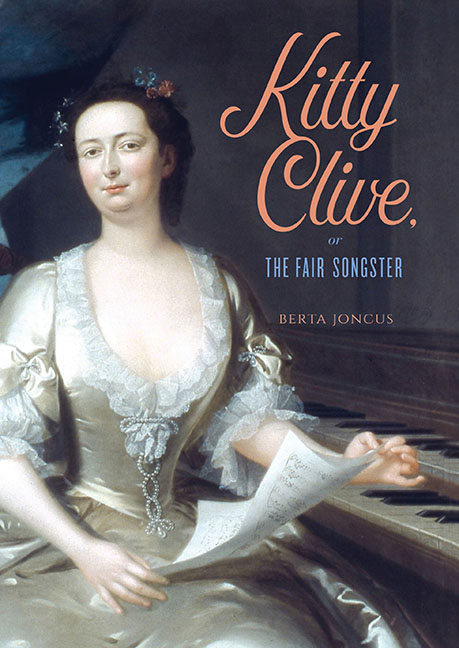Book contents
- Frontmatter
- Dedication
- Contents
- Illustrations
- Preface
- Conventions of Transcription
- 1 The Siren Song: Kitty Clive in the Playhouse
- 2 ‘The Lovely Virgin tun'd her Voice’: Henry Carey and the Production of a Native Songster
- 3 ‘Charm'd with the sprightly Innocence of Nell’: The Metamorphosis of Miss Raftor
- 4 ‘HINT writes, and RAFTOR acts in Drury-lane’: Clive, Fielding, and Theophilus Cibber
- 5 ‘The pious Daughter, and the faithful Wife’: Fielding, Miller, and Clive, 1733–35
- 6 ‘A Likeness where none was to be found’: Contested Images of Clive, 1734–37
- 7 The Patriot Soprano: British Worthies at Drury Lane
- 8 Handel and the Sweet Bird of Drury Lane, 1740–43
- 9 The Case of Mrs. Clive
- 10 Of Scuffles and Rivalries: The Demise of ‘Kitty Cuckoe’
- 11 From Miss Lucy to Mrs. Riot: Voice and Caricature
- 12 Clive on Clive: The Rehearsal: Or, Bays in Petticoats
- 13 Conclusion: The Fair Songster
- Appendix 1 Catherine Clive's Roles 1728–69
- Appendix 2 Lines in Catherine Clive's Repertory 1728–69
- Appendix 3 The Case of Mrs. CLIVE (1744)
- Select Bibliography
- Index
13 - Conclusion: The Fair Songster
Published online by Cambridge University Press: 20 September 2019
- Frontmatter
- Dedication
- Contents
- Illustrations
- Preface
- Conventions of Transcription
- 1 The Siren Song: Kitty Clive in the Playhouse
- 2 ‘The Lovely Virgin tun'd her Voice’: Henry Carey and the Production of a Native Songster
- 3 ‘Charm'd with the sprightly Innocence of Nell’: The Metamorphosis of Miss Raftor
- 4 ‘HINT writes, and RAFTOR acts in Drury-lane’: Clive, Fielding, and Theophilus Cibber
- 5 ‘The pious Daughter, and the faithful Wife’: Fielding, Miller, and Clive, 1733–35
- 6 ‘A Likeness where none was to be found’: Contested Images of Clive, 1734–37
- 7 The Patriot Soprano: British Worthies at Drury Lane
- 8 Handel and the Sweet Bird of Drury Lane, 1740–43
- 9 The Case of Mrs. Clive
- 10 Of Scuffles and Rivalries: The Demise of ‘Kitty Cuckoe’
- 11 From Miss Lucy to Mrs. Riot: Voice and Caricature
- 12 Clive on Clive: The Rehearsal: Or, Bays in Petticoats
- 13 Conclusion: The Fair Songster
- Appendix 1 Catherine Clive's Roles 1728–69
- Appendix 2 Lines in Catherine Clive's Repertory 1728–69
- Appendix 3 The Case of Mrs. CLIVE (1744)
- Select Bibliography
- Index
Summary
Who was Kitty Clive? Her very name suggests her elusiveness: was she baptized Ellenor, as Patrick J. Crean suggests, or Catherine? The former smacks of Ireland, the latter of England. Was she really ‘Mrs. Clive’? Her marriage appears to have been a fiction. And then there's the propriety linked to the name ‘Clive’: was she a paragon of rectitude, as even her detractors long claimed, or was she a Sapphic lover, winking her same-sex loyalties even as she staged sneering mockery of the homosocial man? Clive's story confounds smooth telling.
Archival data apart, what is left to us of Clive are reports and representations. These clash constantly, because Clive was a celebrity of the first order. The business of stars is to create, destroy, elude, and constantly change what audiences think they know about them. Clive commanded these arts in the playhouse, where performer met audience nightly. Physically close, the playhouse star moved between familiarity and mystery: adopting a new dramatis persona on stage, acting and singing in a way that was familiar yet different, pointing up this familiarity and difference, and disappearing once the work ended. A Clive or a Garrick shape-shifted with great ease while being instantly recognizable, embodying a selfhood whose parameters were always fluid.
Voice was Clive's means to convey herself, first in music, then in stage speech, and ultimately in writing. Music schooled her in control – mental, physical, and emotional – and success showed her what audiences wanted. She was cherished for being original, yet her audiences admired not what she bared, but what she showed herself capable of hiding, and how. For Clive, as for many of her contemporaries, voice was a primary means of both concealment and confession. She keyed hers to socia advancement, but possessed a unique sound, a distinct vocal grain with which audience identified her, regardless what character she played. In its poise, her voice dazzled, but left her open to charges of hypocrisy. In its boldness, her voice hooked listeners, but left her open to charges of impudence. When mimicking reigning Italian sopranos, she slipped between compliance with Town fashion and defiance of it, creating her own brand of vocal music. As she toggled between seeming polite and seeming frank, she sometimes succeeded in drowning out, to audience applause, the author's voice with her own.
- Type
- Chapter
- Information
- Kitty Clive, or the Fair Songster , pp. 409 - 426Publisher: Boydell & BrewerPrint publication year: 2019

